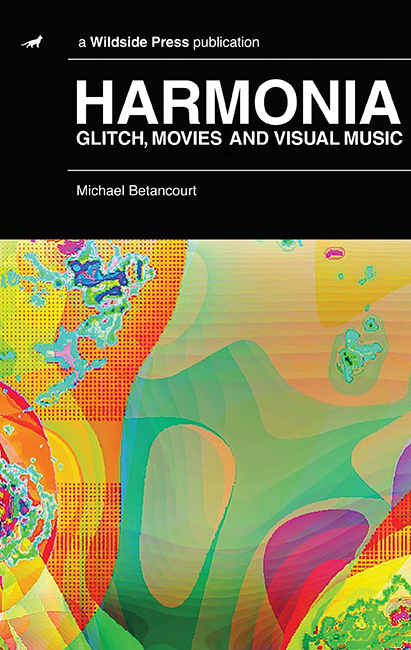PORTFOLIO |
 |
|
|
|
|
|
 |

|
| |
 |
Harmonia: Glitch, Movies and Visual Music - Now Available!
story © Michael Betancourt | published January 9, 2018 | permalink |



 |
| 
|
 |


|
 |

Harmonia, �harmonies,� analyzes the connections between glitch art, visual music, abstraction, and motion pictures. This collection is a chronological survey of glitch art pioneer Michael Betancourt�s artistic research into, around, and with digital motion pictures that theorizes and critiques visual music. This anthology is directly connected to his critical engagement with the socio-cultural meaning of �visionary art� that builds on the work of Umberto Eco and Michel Foucault to engage with the historical films of John Whitney, Mary Ellen Bute, Mary Hallock-Greenewalt, and Stan Brakhage (among others) connecting them with contemporary glitch movies. Included in this collection is his taxonomy of abstract forms based on synaesthesia, a discussion of the historical foundations and connections between color music/color organs, synaesthesia and the visual music instruments and films of the twentieth century, and an analysis of the fundamental connections between visual music and realism that reveals an ideological reification created by the synchronization of sound and image. This analysis goes beyond a historical recounting of artists and their works to propose an understanding of synaesthetic media in aesthetic as well as critical, ideological terms. Included are the essays �The Aura of the Digital,� �The Invention of Glitch Video,� �Semiotics of the Moon as Fantasy and Destination,� and �Welcome to Cyberia� along with many other talks, publications, and analyses of glitch art and visual music.
Harmonia: Glitch, Movies and Visual Music is an anthology of my writing on glitch and visual music. It's available in hardcover and paperback, 240 pages.
|

|
|
|

|
| |

|
| |

|
| |
 |
notes on 'The Fantasy of Equivalence'
story © Michael Betancourt | published December 7, 2017 | permalink |



 |
| 
|
 |


|
 |
|
An erasure of ontological distinctions plays a crucial role in the commodification of human labor as an assumption of equivalence between not only differently skilled labor, but the products of that labor: that the variable quality of production does not figure into its valuations. This basis is innate to the question Karl Marx addresses at the start of his analysis, �Why is labor represented by the value of its product (commodities), and labor time by the magnitude of that value?,� which reveals equivalence as a foundational, even necessary part of the definition of capitalism. Although exchange value arises from social activity, it is at the same time dependent on the suspension of difference�equivalence reifies the commodity form as an abstraction apart from its materiality, a separation that recalls the aura of the digital�returning digital capitalism to its origins in the industrial labor. Marx�s analytic enshrines equivalence by setting aside distinctions between high and low quality, as well as between skilled and unskilled labor, in order to advance an abstraction of that productive process that depended on the assumption of the interchangeability of commodities, labor, and capital. His disregard for the material and qualitative differences between commodities mirrored the labor-intensive manufacturing processes of the period when he developed his critique: the concern with the productive capabilities of labor as a constraint on production provides a literal limit on quantity, valuation, and quality of the productive labor performed, for example, by the unskilled child labor employed in the factories Marx was considering. This issue�child labor�is an implicit and unacknowledged component assumption for his analytic, one that simultaneously passes without comment in its construction but that guides the conclusions he derives.
|

|
|
 read more read more
|

|
| |
|
|
|